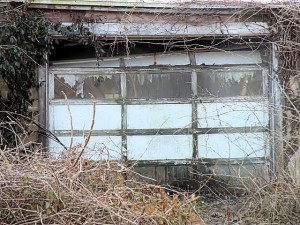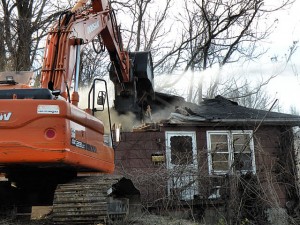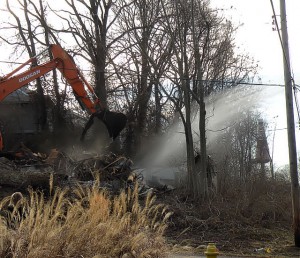Kenny and Betty owned the house at 200 Angle St. in Collinsville for years. They lived an unhealthy lifestyle that included allowing up to seven dogs to roam the house, not taking the dogs outside to go to the bathroom.
The couple had an overpowering odor that caused at least one local business to immediately spray the premises with air freshner after Kenny and Betty left the store, neighbor Mathew Connor said. But the offending odor was not just attached to the couple.
“When I went into the house, I realized it was the house (that smelled),” Connor said. “It just smelled like death.”
The house decayed while Kenny and Betty lived in it together. After Kenny died four years ago, Betty shut herself in a back room, chain-smoked, collected the ashes in large coffee cans and allowed the dogs to defecate where they pleased in the house, Connor said.
After Betty died two years ago, Maria Solva, another neighbor, watched police with masks over their faces enter the home her mother-in-law sold to Kenny and Betty. The masks were to protect them from a house so dirty people were afraid to enter without protection.
The house was offered for sale, but did not generate any buyer interest. “The house was so bad, no one could have lived there,” Solva said.
After two years of sitting vacant, the house just steps from Collinsville’s most famous landmark, the World’s Largest Catsup Bottle, became an overgrown eyesore with no hope of being sold. It also became a target of the City of Collinsville’ program to remove blighted homes from neighborhoods.
The program identifies derilict homes and forces the owners to bring the house up to code, pay for demolition costs, or relinquish their rights so the city can perform the demolition. There were 12 homes demolished in 2013 under the program and another 12 are slated so far for 2014.
Removing the homes is a quality of life issue, City Manager Scott Williams said. The houses targeted for demolition have become derelict and dangerous.
After the homes are demolished, the owners, if the city does not own the property, are held responsible for upkeep of the land. If they fail repeatedly, the city, which will have a lien on the property, can repossess it and sell it.
Four city owned properties were recently sold via silent auction. The sales were approved at the Jan. 13, 2014 City Council meeting.
“Collinsville has a number of derelict properties that we would like to see redeveloped,” Williams said. “That will improve the quality of life in those neighborhoods.”
Redevelopment is the ideal outcome of the program, Community Development Director Mitch Bair said. “The ultimate goal is to get the properties back on the tax roll,” Bair said. “But it’s more for the impact on that neighborhood.”
The code enforcement office receives numerous complaints about derelict buildings in the city. Some are drug house, some flophouses and all are eye-sores, Bair said.
“One problem is that they are unattractive and a pain to live next to, another is the illegal activity,” Bair said.
The process of going from derelict home to brand new home on the same property is a complex one involving numerous legal steps and complications. A common hurdle to completing the process is identifying the current owner, Bair said.
Many of the homes in the program were owned by victims of the financial crisis that began in 2008. Banks own some of the properties and for others the foreclosure process was started but dropped when the bank realized the property was not worth enough, Bair said. It can be difficult to find the legal owner of homes that were in poor condition when the owner died, Bair said.
Courts allow the demolition of derelict homes when it is shown that the owner cannot be identified. The city will then put a lien against the property. If someone later claims the land, the person will be responsible for the demolition and maintenance costs.
The vacant lots with no owner identified become part of another city program, lawn mowing. When the city cuts the grass on a lot it does not own, and for which the owner is known, that owner is charged the city’s costs plus a fine. After the lawn is cut a third time without the owner agreeing to maintain the lot, the fine increases to $750 per infraction.
The aggressive fines have encouraged most owners to take over the maintenance. The city was cutting 50 lawns a few years ago, Bair said, but that amount has dropped to 18. Fines totaling $20,000 were recovered in the program in 2013. The program cost the city $7,7000.
When the city has clean ownership of a lot, it attempts to sell them, hoping the buyer will want to rebuild on the property. The city also hopes to recoup demolition costs – which are between $5-6,000, Bair said – and have a sale price at or above the assessed value.
Two of the four homes sold on Jan. 13 were for less than the appraised value. One sold for $4,000 – meaning the city was not able to re-coup the demolition costs – and another property for $5,000.
The city’s end goal is not necessarily to maximize profit on the demolitions. Providing peace of mind to the neighbors and getting the land back on the tax role are the city’s primary objectives, Bair said.
The neighbors of 200 Angle had mixed feelings as the building was brought down. Solva was happy to see it go, but Connor was conflicted.
“I can understand why they are doing it,” Connor said. “Sometimes it’s easier to rebuild than to try to rehab something that is covered in filth and grime.”
Watching the home being torn down, however, brought back memories of Connor’s friend.
“It is just making me think of Betty, she was such a nice person” Connor said.







Roger,
I read M.I. regularly especially when I’m in Tucson. Your selection, editing & writing, also photos are all excellent & I don’t see how you DO IT — as a one person publisher, editor, reporter, etc.
I’m still so disappointed that Collinsville has no print newspaper but I am grateful that you provide us with the MetroIndependent. Smaller towns in Illinois still have newspapers, as for example, Sterling, but I realize that it gets more difficult every year for print to continue. I’m even disappointed with the St. Louis Post-Dispatch these days.
A year ago I promised you a financial token gift & I haven’t sent that so please send me your mailing address. I hope that more local businesses are helping with ads.
Congratulations, good luck & my continuing thanks for the new year.